Definition
A spinal corticosteroid injection places corticosteroids into tissue around the spine. Corticosteroids are drugs that reduce painful swelling and irritation, called inflammation. They are injected into the back with a needle.
Reasons for Procedure
- To diagnose whether a specific site in the spine is the cause of persistent pain or disability
- To reduce pain caused by swelling or inflammation around the spine
- Improve physical function for people with persistent low back pain and/or sciatica
Spinal injections are typically performed when persistent pain and disability are not relieved by:
- Rest
- Ice and heat therapies
- Medicines
- Physical therapy
- Back exercises
- Changes to the physical set-up of the work environment
- Changes to physical activities, including work
- Spinal manipulation
Possible Complications
Complications are rare, but no procedure is completely free of risk. If you are planning to have an injection, your doctor will review a list of possible complications, which may include:
- Headache
- Allergic reaction to the medicine
- Bleeding
- Infection
- Nerve damage
- Fainting
Some factors that may increase the risk of complications include:
- Current infection
- Certain pre-existing medical conditions
- Treatment with blood thinners or certain other medicines
- General ill health
What to Expect
Prior to Procedure
Your doctor may:
- Perform a brief physical exam
- Order an X-ray —a test that uses radiation to take a picture of structures inside the body, especially bones
- Order an MRI scan —a test that uses magnetic waves to make pictures of structures inside the body
- Order a CT scan —a type of x-ray that uses a computer to make pictures of the inside of the body
Talk to your doctor about your medicines. You may be asked to stop taking some medicines up to one week before the procedure, like:
- Aspirin or other anti-inflammatory drugs
- Blood thinners, such as clopidogrel (Plavix) or warfarin (Coumadin)
Anesthesia
A local anesthetic and/or a sedative may be used. They may help to alleviate pain andanxiety. You will be awake for the procedure.
Description of the Procedure
You will lie on your side on an x-ray table. The skin on your back will be washed with a sterile solution. A syringe containing corticosteroid medicine and a local anesthetic will be prepared. The needle will be injected through the skin and into a space near the spine. The doctor will likely use x-ray imaging to guide placement of the needle. Contrast material may also be injected to confirm that the needle is in the right place. The medicine will be injected and the needle will be removed from your back. A small bandage may then be placed over the injection site.

How Long Will It Take?
The procedure will take less than one hour. The entire visit takes about 2-3 hours.
Will It Hurt?
The injection of the local anesthetic may burn or sting for a few seconds. After that, you should not feel pain during the procedure.
Post-procedure Care
At the Care Center
- You will spend time in a recovery area.
- A healthcare professional will monitor your recovery.
- Because you were sedated during the procedure, you will need someone to drive you home.
- Potential temporary side effects include:
- Brief period of increased pain
- Headaches
- Trouble sleeping
- Facial flushing
- Hiccups
- Lightheadedness from low blood pressure
At Home
When you return home after the procedure, do the following to help ensure a smooth recovery:
- Rest on the day of the procedure.
- Apply ice packs for soreness at the injection site.
- Avoid baths, pools, and whirlpools for 24-48 hours.
- Be sure to follow your doctor’s instructions .
It will take a few days to a week for the medicine to reduce the inflammation and pain. You should be able to resume your regular daily activities the day after the procedure. You should be able to start exercising within one week.
Call Your Doctor
After arriving home, contact your doctor if any of the following occurs:
- Signs of infection, including fever and chills
- Redness, swelling, increasing pain, bleeding, or discharge from the injection site
- Shortness of breath or chest pain
- Numbness, tingling, pain, or weakness, especially in the arms, hands, legs, or feet
- Changes in urine or bowel function
- Sudden increase in weight of more than five pounds
In case of an emergency, call for medical help right away.
